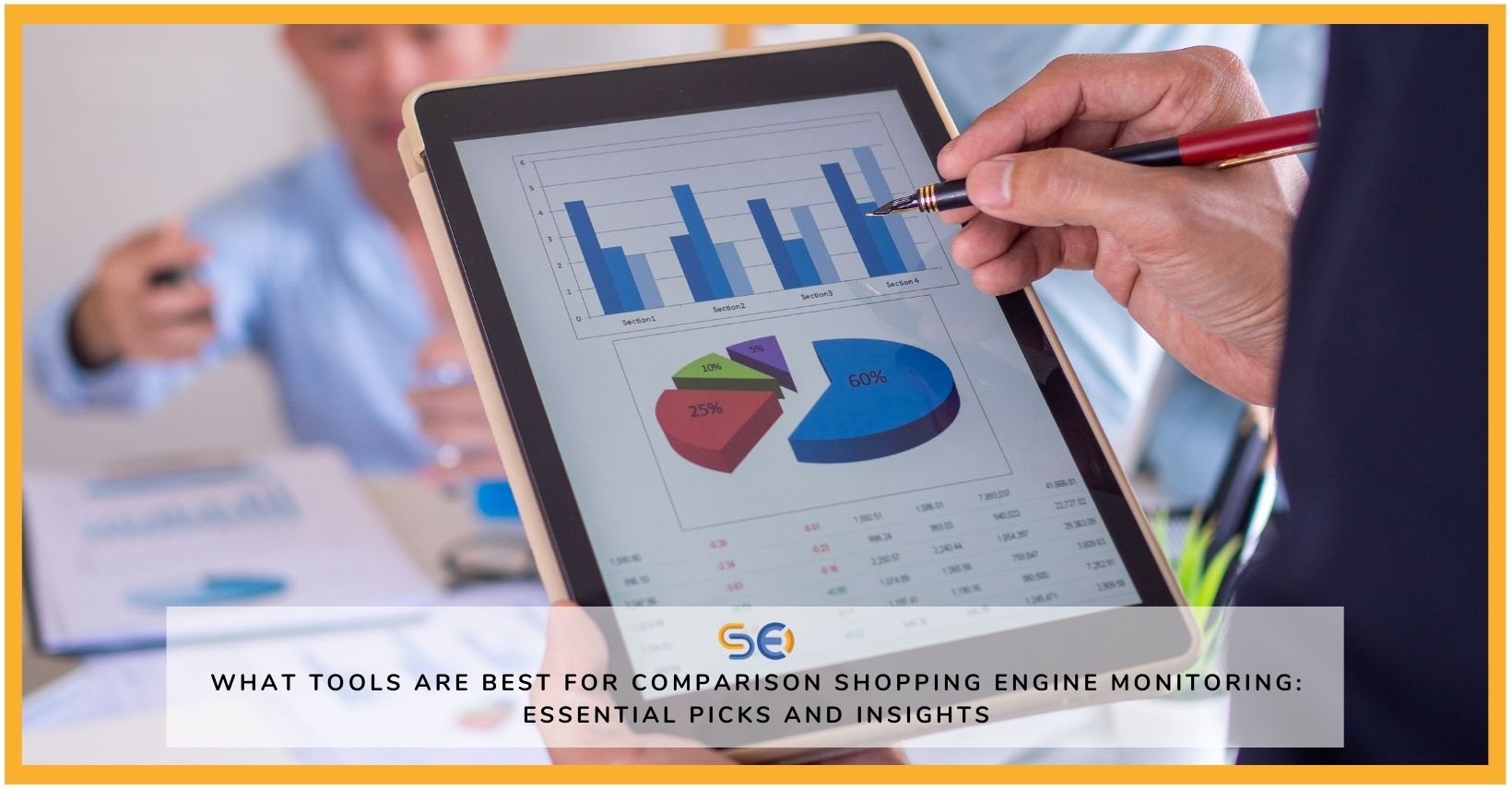In the fast-paced world of online shopping, businesses must keep an eye on the competition to stay ahead.
Comparison Shopping Engine Monitoring tools offer valuable insights into pricing, products, and performance metrics to help businesses make informed decisions.
We will explore the best tools available for Comparison Shopping Engine Monitoring, including Google Shopping Insights, SEMrush, Price2Spy, Optimum7’s tool, and Prisync.
Learn how these tools can aid in real-time data tracking, competition analysis, and automation.
Stay tuned for expert recommendations and tips to boost your online presence and outshine the competition with the right tools for your business. Below is an explanation of what comparison shopping engine monitoring is.
What Is Comparison Shopping Engine Monitoring?
Comparison shopping engine (CSE) monitoring involves tracking and analysing data from various shopping engines to gain competitive intelligence and boost advertising effectiveness.
By monitoring CSEs, businesses can gain valuable insights into their competitors’ pricing strategies, product assortment, and promotional tactics. This information is important for making informed decisions about pricing adjustments, product offerings, and marketing strategies. CSE monitoring enables companies to identify emerging trends in the market and stay ahead of the competition.
This process optimises advertising campaigns by providing real-time consumer behaviour and preferences data. CSE monitoring allows businesses to analyse ad performance on different platforms, track conversion rates, and refine targeting strategies for better audience reach. Understanding these aspects highlights why comparison shopping engine monitoring is important.
Why Is Comparison Shopping Engine Monitoring Important?
Comparison shopping engine monitoring is essential because it provides valuable competitive intelligence that helps businesses enhance their advertising strategies, better understand their clients, and prevent unauthorised ads from appearing.
By analysing data from CSE monitoring, businesses gain insights into competitors’ pricing strategies, product offerings, and market positioning. This information aids in making informed decisions to improve advertising campaigns and outshine rivals. Understanding client behaviour allows companies to customise promotions and product recommendations, enhancing customer satisfaction and loyalty. Best tools for comparison shopping engine monitoring are essential for achieving these goals.
What Are the Best Tools for Comparison Shopping Engine Monitoring?
Several tools stand out as the best for effectively monitoring comparison shopping engines. These tools provide special features for tracking data from competitor websites and various verticals, making them critical for businesses seeking to optimise their advertising strategies. Below are the best tools for comparison shopping engine monitoring.
Google Shopping Insights
Google Shopping Insights is a powerful tool that provides comprehensive analytics to help businesses optimise their advertising strategies on Google Shopping.
Using Google Shopping Insights, businesses gain valuable data on popular search terms, trending products, and consumer preferences. This information allows them to effectively tailor their campaigns to target exact demographics, regions, and timeframes. The tool offers insights into competitors’ performance, enabling companies to identify market trends and adjust their approach to stay ahead in the competitive landscape.
SEMrush
SEMrush is a versatile tool that provides competitive intelligence for both SEO and SEM, making it a valuable asset for businesses engaged in comparison shopping engine monitoring.
One of SEMrush’s key features is its ability to conduct comprehensive keyword research. This helps users identify high-ranking keywords and optimise their content accordingly. SEMrush also offers a backlink analysis tool that allows businesses to monitor their competitors’ backlink profiles and devise strategies to improve their link-building efforts.
SEMrush provides detailed analytics on organic and paid search traffic, enabling businesses to track their performance and make data-driven decisions to boost their online visibility. The platform also offers SEO audit tools to identify and fix on-page issues that may impact search engine rankings.
Price2Spy
Price2Spy specialises in price monitoring and offers robust analytics to help businesses monitor price changes and trends across various comparison shopping engines.
One of Price2Spy’s key features is its real-time ability to track competitor pricing, allowing businesses to react swiftly to market changes. The platform provides detailed insights into pricing strategies, market positioning, and product availability, helping businesses make informed decisions. With customisable alerts and reports, users can easily identify pricing anomalies and adjust their pricing strategy accordingly. Price2Spy also offers historical data analysis, enabling businesses to identify pricing patterns and optimise pricing strategies for maximum profitability.
Optimum7’s Comparison Shopping Engine Monitoring Tool
Optimum7’s Comparison Shopping Engine Monitoring Tool is designed to enhance advertising campaigns with advanced analytics and comprehensive monitoring features.
This tool provides insights into consumer behaviour patterns through real-time data analysis, allowing advertisers to make informed decisions based on market trends.
The detailed monitoring capabilities track key performance indicators, ensuring that every aspect of the campaign is optimised for maximum ROI.
The tool’s user-friendly interface simplifies analysing campaign performance, making it accessible to marketers of all skill levels.
Prisync
Prisync is renowned for its price monitoring capabilities, which allow businesses to track prices on competitor websites and make informed pricing decisions.
By utilising Prisync, companies can gain valuable insights into their competitors’ pricing strategies, helping them stay competitive. The automated monitoring system provided by Prisync saves businesses time and effort, eliminating the need for manual price checks. This detailed pricing data enables companies to adjust their prices dynamically based on real-time market trends and competitor movements. With Prisync’s notification feature, businesses receive alerts whenever a competitor changes their prices, ensuring they can promptly respond and adapt their pricing strategies. In the fast-paced e-commerce world, accurate pricing intelligence is vital to staying ahead of the competition.
How Do These Tools Help with Comparison Shopping Engine Monitoring?
The comparison shopping engine monitoring tools assist businesses in various ways, from providing detailed analytics and improving advertising effectiveness to offering dedicated support teams to ensure optimal performance.
Real-time Data Tracking
Real-time data tracking is important for businesses to immediately adjust their advertising strategies based on up-to-date analytics.
By leveraging real-time data, companies can swiftly identify trends, consumer behaviour patterns, and campaign performance metrics.
This enables them to promptly adapt their messaging, targeting, and budget allocations to maximise their return on investment.
Implementing a robust analytics system allows organisations to measure their marketing efforts’ impact accurately.
Price and Product Monitoring
Price and product monitoring are essential aspects of CSE monitoring, providing businesses with the competitive intelligence needed to stay ahead in the market.
By consistently tracking the prices of their products and those of their competitors, companies can analyse market trends and consumer behaviour and adjust their pricing strategies accordingly. This data-driven approach enables businesses to make informed pricing, promotions, and product positioning decisions.
Monitoring product availability and customer reviews across various platforms helps understand customer preferences and optimise product offerings to meet market demands effectively.
Competition Analysis
Competition analysis involves scrutinising competitors’ websites and identifying unauthorised ads to ensure your business remains competitive and compliant.
By looking into your competitor’s online presence, you can gather valuable insights into their strategies, target audience, and advertising tactics.
This analysis enables you to benchmark your marketing efforts, capitalising on their weaknesses and leveraging your strengths.
Spotting unauthorised ads on their platforms can provide important intel on their partnerships, potential revenue sources, and areas where they might be cutting corners.
Performance Metrics and Reporting
Performance metrics and reporting are integral components of CSE monitoring. They provide businesses with detailed analytics to measure the success of their strategies.
By tracking key performance indicators (KPIs), companies can gain insights into customer behaviour, market trends, and the effectiveness of their marketing campaigns. Performance metrics help evaluate the ROI of different initiatives and understand the impact of various factors on overall business performance.
Through regular performance reporting, organisations can identify areas for improvement and make data-driven decisions to optimise their operations. This proactive approach enables businesses to refine their strategies, enhance customer satisfaction, and stay ahead of competitors in the dynamic market landscape.
Automation and Optimization
Automation and optimisation features in CSE monitoring tools save important employee hours and enhance the efficiency of advertising campaigns.
One key advantage of utilising automation and optimisation functionalities in CSE monitoring tools is the ability to streamline repetitive tasks, allowing employees to focus on more strategic initiatives.
Businesses can free up valuable human resources by automating routine processes like data collection, analysis, and reporting. This leads to increased productivity and cost savings. Optimisation capabilities fine-tune advertising campaigns, identify target audience preferences and refine real-time strategies. Understanding these benefits is important. What Factors Should Be Considered When Choosing a Comparison Shopping Engine Monitoring Tool is the next essential topic to explore.
What Factors Should Be Considered When Choosing a Comparison Shopping Engine Monitoring Tool?
When selecting a comparison shopping engine monitoring tool, consider customer support’s price, features, and quality. These elements are essential for making an informed choice. Below are factors to consider when choosing a comparison shopping engine monitoring tool.
Price
Price is a critical factor when selecting a comparison shopping engine monitoring tool, as it needs to fit within your budget whilst providing the necessary features.
Balance cost and functionality to ensure the best value for your investment. Before deciding, carefully analyse the tool’s features and compare them with your requirements.
Consider the tool’s scalability; you want one that can grow with your business. To maximise your experience, look for user-friendly interfaces and excellent customer support.
Features and Functionality
The features and functionality of a comparison shopping engine monitoring tool are crucial, as they determine the tool’s ability to leverage advanced technologies and meet your exact needs.
When selecting a CSE monitoring tool, it is essential to prioritise real-time data tracking to stay up-to-date with market trends and competitors’ pricing strategies. Automated alerts for price changes and stock availability can give you a competitive edge by enabling swift responses. A user-friendly interface and customisable reporting capabilities enhance the user experience and promote insightful decision-making. Integration with multiple marketplaces and platforms is also key for comprehensive monitoring and effective management of your online presence.
User-Friendliness
User-friendliness is an important consideration, as the platform should be easy to navigate and use, ensuring that all team members can effectively utilise its features.
When a CSE monitoring tool is user-friendly, it leads to enhanced productivity and streamlined workflows. Team members can quickly access the necessary data and insights without facing hurdles, improving decision-making processes. A user-friendly interface reduces the need for comprehensive training sessions, saving the organisation time and resources. Clear information organisation and intuitive design also contribute to a positive user experience, fostering greater user engagement and satisfaction.
Customer Support
Reliable customer support is vital when selecting a CSE monitoring tool. A dedicated support team can help resolve issues quickly and ensure the platform runs smoothly.
Strong customer support goes beyond fixing problems; it builds user trust and loyalty. A knowledgeable support team can provide guidance on using the tool efficiently, offer tips for maximising its features, and address any concerns promptly. This level of assistance enhances the platform’s usability and increases user satisfaction and retention rates.
Integration Options
Integration options are essential, as the CSE monitoring tool should seamlessly work with existing platforms and technologies to provide a coherent user experience.
Various integration options allow businesses to streamline their operations and data flow, improving efficiency and productivity. Connecting the monitoring tool with different systems ensures a smooth flow of information across the organisation.
Ensuring compatibility is important for seamless business operations, reducing errors and avoiding duplication. Integrating with existing platforms enhances the tool’s capabilities by leveraging their functionalities. This natural flow leads to our final thoughts on choosing the best comparison shopping engine monitoring tools.
Final Thoughts on Choosing the Best Comparison Shopping Engine Monitoring Tools
Selecting the best comparison shopping engine monitoring tools involves considering various factors such as advertising effectiveness, competitive intelligence, and the overall user experience provided by the tool.
Businesses can optimise their marketing strategies and maximise their ROI by choosing a tool that excels in tracking advertising performance across multiple platforms.
Platforms that offer strong competitive intelligence features enable companies to stay ahead of their rivals by analysing market trends and competitor activities.
The tool’s user experience is important as it directly impacts the efficiency of ad monitoring and the ease of accessing valuable insights.




